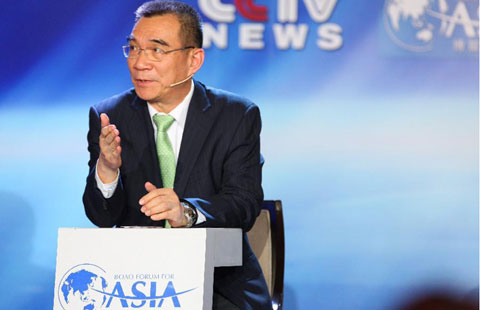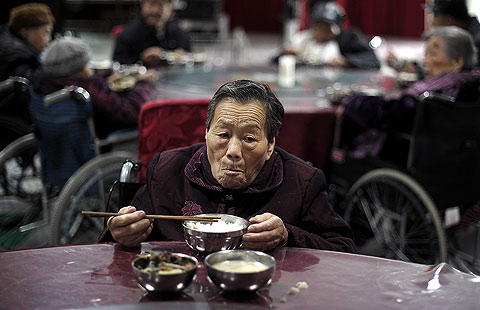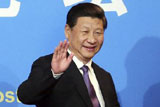Growth amid changes to the economy
Updated: 2014-04-10 15:53
By Liao Min (China Daily USA)
|
|||||||||
In his first work report to the National People's Congress, Premier Li Keqiang set China's GDP growth target at about 7.5 percent for the third straight year in 2014 and pledged to continue economic reforms.
China's economy was described as being at an inflection point, where the paths upward are "particularly steep" amid domestic and foreign challenges.
"The foundation for steady economic growth is not yet firm, while the internal momentum for growth needs to be stronger," Li said.
The world economy still faces instability and uncertainties, as macroeconomic adjustments by some countries introduce new variables, while emerging economies face new difficulties and challenges, he said.
Domestically, Li cited risks from public finance and banking, overcapacity, difficulties in exercising macroeconomics and increasing agricultural output and rural incomes as major challenges.
Li spoke of a long list of challenges. Can China meet them?
With fresh signs of economic weakness in February, will China be able to achieve its 7.5 percent growth goal?
With a 7 percent-plus growth rate, can China succeed in changing its economic model based on exports and investment?
The answer is probably yes to all three questions, for three reasons.
First, industrialization and urbanization offer many new opportunities.
China will grant urban residence permits (hukou) to about 100 million rural people who have moved to cities all over the country, renovate rundown urban areas where about 100 million people live and encourage the urbanization of about 100 million rural residents of the central and western regions in their own cities.
These urbanization efforts will take time, but they're sure to pay off.
Second, consumption will serve as the major engine of the economy, while investment will be the key to stabilizing GDP growth. The government intends to promote service consumption, as China turns away from its export-driven past.
China needs to invest in a safety net for its aging population, in health facilities, senior housing, tourism and cultural services.
A stronger Internet infrastructure for e-commerce and improved logistics are also on the agenda to boost consumption.
On the side of investment, the central government has budgeted 457.6 billion yuan ($75 billion) for subsidized housing, agriculture, irrigation and water, railways in central and western China, energy conservation and environmental protection.
Third, China's switch to high-end exports will offset rising labor costs. The nation also expects a "talent bonus" to follow the end of the demographic dividend.
Over the past two years, Chinese exports to the US of high-tech electronics, vehicle parts and optical devices rose 24 percent, while exports of clothes and footwear rose just 5 percent. These trends are expected to continue.
In the meantime, China had 2.5 times as many college graduates in 2013 than a decade earlier. A more skilled and entrepreneurial labor force has become an important factor in making the economy more efficient and productive.
With growth and reform plans on track, China's private sector remains an attractive destination for foreign investors.
In the banking sector, for example, Shanghai-based foreign banks plan to open more than 100 outlets around the country in 2014.
The China (Shanghai) Pilot Free Trade Zone, which opened in September as a testing ground for reform, gives greater access to foreign companies to unleash diversity and competition.
So far, nine foreign-funded banks have set up sub-branches in the FTZ; 11 are preparing for the launch of their FTZ sub-branches; a dozen foreign banks are conducting feasibility studies. They are or will be in the FTZ, because the opportunity is there.
The promised reform in the premier's report - letting the market play a decisive role - is sure to benefit the private and financial sectors, including banks, either foreign or domestic.
As China enters a critical juncture in its transition process, the factors that drove its blistering expansion in the past 30 years are changing swiftly. As China becomes more integrated into global markets, volatility and risks increase.
It's structural reform that can enhance the flexibility and resilience of the economy and financial system, leading to slower but better-quality growth, which is good for both China and the rest of the world.
The author is director-general of China Banking Regulatory Commission's Shanghai Office.
(China Daily USA 04/10/2014 page11)

 Top 10 China archeological discoveries for 2013
Top 10 China archeological discoveries for 2013
 Mummy & me in New Zealand
Mummy & me in New Zealand
 Chinese schools vie in moot court
Chinese schools vie in moot court
 Australian divers start underwater search for MH370
Australian divers start underwater search for MH370
 Cleaver-wielding man subdued after tense standoff
Cleaver-wielding man subdued after tense standoff
 Pro-Russian demonstrators announce Kharkov's independence
Pro-Russian demonstrators announce Kharkov's independence
 Breakdancer 'freezes' in front of Paris landmarks
Breakdancer 'freezes' in front of Paris landmarks
 TV Debate in Boao Forum for Asia Annual Conference
TV Debate in Boao Forum for Asia Annual Conference
Most Viewed
Editor's Picks

|

|

|

|

|

|
Today's Top News
Ships sale to Taiwan 'unlikely'
Hagel gets closer to PLA
21 injured in Pennsylvania school
World leaders join Weibo
Beijing could lead clean-energy debate
China's mixed stories in quest for resources
Crimes of Hirohito on stage: 'We can't let it happen again'
Cross-border deals headed south?
US Weekly

|

|








